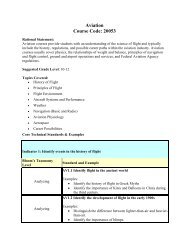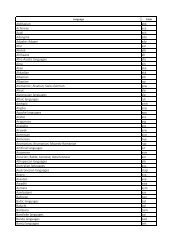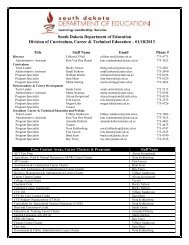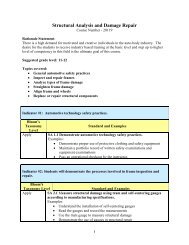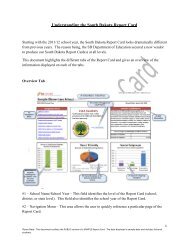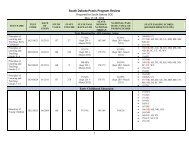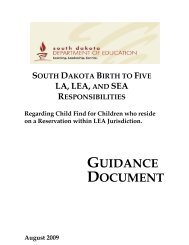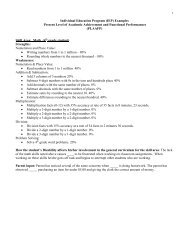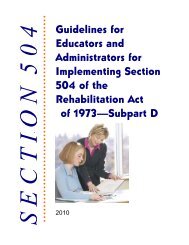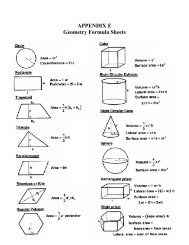Literacy in History/Social Studies Common Core State Standards ...
Literacy in History/Social Studies Common Core State Standards ...
Literacy in History/Social Studies Common Core State Standards ...
You also want an ePaper? Increase the reach of your titles
YUMPU automatically turns print PDFs into web optimized ePapers that Google loves.
●<br />
●<br />
●<br />
Know<br />
(Factual)<br />
How to analyze paragraph<br />
structure: topic sentence,<br />
support<strong>in</strong>g evidence,<br />
details, and transitional<br />
words<br />
How to analyze<br />
Informational text and text<br />
structures. (e.g.,<br />
sentences, paragraph,<br />
chapter, section)<br />
How to analyze various<br />
patterns of organization<br />
(e.g..<br />
sequence/chronological<br />
order, classification,<br />
def<strong>in</strong>ition, process,<br />
description, comparison,<br />
problem/solution, simple<br />
cause/effect,<br />
conflict/resolution.<br />
● How to analyze ·<br />
Various text features<br />
(e.g., title, author, cover,<br />
pictures, captions, maps,<br />
chapter head<strong>in</strong>gs,<br />
<strong>in</strong>formation from charts<br />
and graphs, illustrations,<br />
glossaries, <strong>in</strong>dices)<br />
●<br />
How to analyze key<br />
concepts<br />
Understand<br />
(Conceptual)<br />
The students will understand that:<br />
Sentences play different roles <strong>in</strong> a paragraph. A<br />
topic sentence <strong>in</strong>troduces the ma<strong>in</strong> idea of a<br />
paragraph.<br />
Support<strong>in</strong>g evidence expla<strong>in</strong>s or adds clarity to<br />
the idea expressed <strong>in</strong> the topic sentence.<br />
Details add <strong>in</strong>terest to the paragraph.<br />
Transitional words connect ideas between<br />
sentences and paragraphs.<br />
The structure of a paragraph <strong>in</strong>fluences the<br />
overall mean<strong>in</strong>g of a text.<br />
Authors select specific patterns of organization<br />
to convey <strong>in</strong>formation.<br />
Author’ choices, <strong>in</strong>clud<strong>in</strong>g patterns of<br />
organization, structure, and text features, control<br />
the central idea and the readers’ perceptions.<br />
Good readers/researchers use their knowledge<br />
of organizational patterns <strong>in</strong> <strong>in</strong>formational text(s)<br />
<strong>in</strong> order to make mean<strong>in</strong>g.<br />
Do<br />
(Procedural, Application, Extended<br />
Th<strong>in</strong>k<strong>in</strong>g)<br />
Identify paragraph structure (topic<br />
sentence, support<strong>in</strong>g evidence,<br />
details, and transitional words).<br />
Identify patterns of organization.<br />
Expla<strong>in</strong> how sentences develop<br />
and ref<strong>in</strong>e a key concept <strong>in</strong> a<br />
paragraph.<br />
Make connections between<br />
author’s choice of text structure<br />
and the text’s purpose, key po<strong>in</strong>ts,<br />
and central idea(s).<br />
Analyze the structure of a<br />
paragraph <strong>in</strong> a text.<br />
Expla<strong>in</strong> how organization,<br />
structure and/or features enhance<br />
text’s purpose and central idea.<br />
Analyze how a text uses structure<br />
to emphasize key po<strong>in</strong>ts or<br />
advance an explanation or<br />
analysis<br />
Design paragraphs that meet<br />
specifications for designated<br />
patterns of organization<br />
(e.g. problem/solution,<br />
compare/contrast, process, etc).<br />
Key Vocabulary:<br />
analyze structure develop<br />
ref<strong>in</strong>e key concept paragraph<br />
transitional words topic sentence support<strong>in</strong>g evidence/reasons, details, facts<br />
details<br />
Relevance and Applications: How might the grade level expectation be applied at home, on the job or <strong>in</strong> a real-world,<br />
relevant context? Include at least one example stem for the conversation with students to answer the question “why do<br />
I have to learn this?”<br />
Analyz<strong>in</strong>g and <strong>in</strong>terpret<strong>in</strong>g <strong>in</strong>formational texts is important because it helps you understand th<strong>in</strong>gs <strong>in</strong>clud<strong>in</strong>g warranties,<br />
user manuals, and contracts.<br />
If you mis<strong>in</strong>terpret or misunderstand key details, you may miss important steps or <strong>in</strong>formation that can impact you <strong>in</strong> a<br />
negative way. For example, if you misread the contract on your cell phone, you may <strong>in</strong>cur more charges than you<br />
anticipate.



